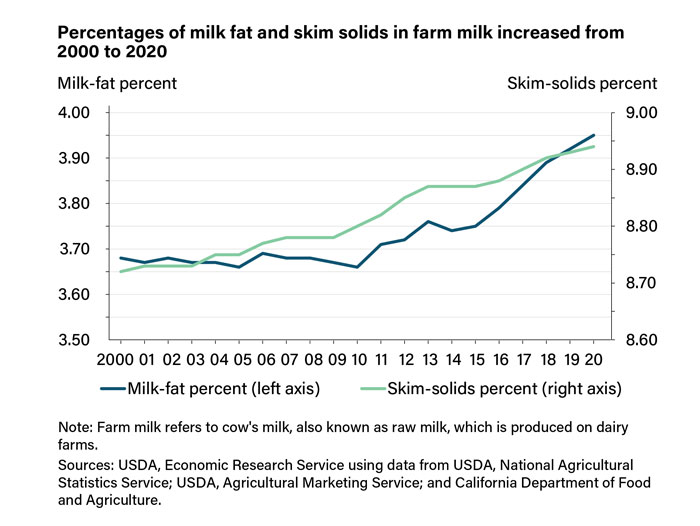Farm Milk Components and Their Use Among Dairy Products Have Shifted Over Time
August 16, 2021 | 2 min to read

Milk consists of water, milk fat, and skim solids. Skim solids include protein, lactose, minerals, and trace elements. The average percentages of both milk fat and skim solids in farm milk (cows’ milk from dairy farms) have increased in the last two decades. In 2000, U.S. farm milk contained 3.68 percent milk fat and 8.72 percent skim solids on average. By 2020, the milk-fat percentage had grown to 3.95 percent, and the skim-solids percentage had increased to 8.94 percent. For skim solids, content increased gradually from 2000 to 2020, while milk-fat content began rising in 2011, after remaining relatively steady from 2000 to 2010.
The Dietary Guidelines for Americans, published by USDA and the U.S. Food and Drug Administration, recommend “fat-free or low-fat milk, yogurt, and cheese, and/or lactose-free versions and fortified soy beverages and yogurt as alternatives.” While the Dietary Guidelines continue to recommend low-fat dairy, some studies receiving attention in the general media have indicated less of a health risk in milk-fat consumption than had been previously perceived. Other studies have suggested that there are nutritional benefits in milk fat. As a result, demand for higher-fat milk products has increased substantially over the last decade. Through an adjustment in production practices or shifting to breeds that produce higher fat milk, farmers have been able to increase fat content in the milk. While Holstein cows—the iconic black and white (or sometimes red and white) dairy cows—remain the predominant species of dairy cows in the United States, farms are increasingly shifting to other breeds, such as Jersey cows, which produce higher-fat milk naturally. Improvements in genetics of the major breeds and higher quality livestock feeds also have contributed to the increasing richness of milk.
Consumer Trends Shape Component Allocations in Fluid Milk and Cheese
USDA’s Economic Research Service (ERS) tracks the percent of milk fat and skim solids allocated or used among different dairy products in Supply and Allocation of Milk Fat and Skim Solids by Product, found at ERS’s Dairy Data web page. The data show that changes in consumption patterns from 2000 to 2019 (the most recent year for which complete data are available) influenced the percentages of milk fat and skim solids of the two largest dairy product categories, fluid beverage milk (hereafter simply called fluid milk) and cheese.
To read the rest of the story, please go to: USDA ERS
